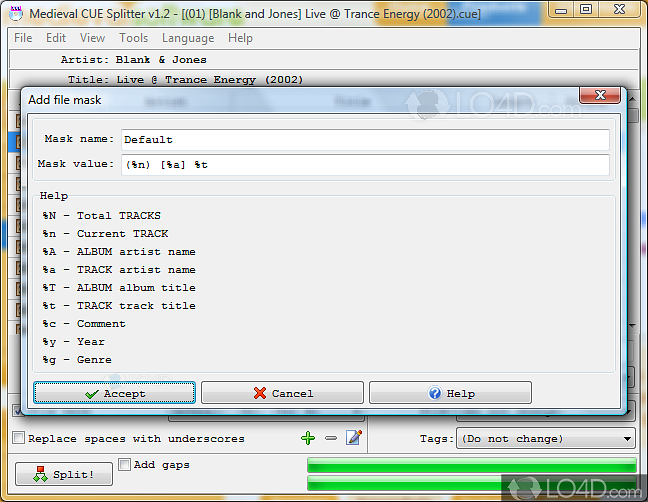


- Create a custom file mask in cue splitter how to#
- Create a custom file mask in cue splitter full#
- Create a custom file mask in cue splitter portable#
- Create a custom file mask in cue splitter software#
- Create a custom file mask in cue splitter license#
verbatim) copies of the Program as you receive it throughout the world, in any medium You may copy and distribute literal (i.e. A token is a string formed by a percentile sign followed by an identification character, for example A, t, n, c, and so on. A file mask can contain one or more token. Actually file mask is used in CUE Splitter to generate audio, M3U and CUE file names. Permission is granted to use the Program for non-commercial, non-military purposes A file mask is a string used to generate an output file name.
Create a custom file mask in cue splitter license#
Licensor hereby grants you the following rights, provided that you comply with all of the restrictions set forth in this License and provided, further, that you distribute an unmodified copy of this License with the Program:
Create a custom file mask in cue splitter portable#
Automatically generates an M3U and M3U8 playlist file ready for Winamp (and other players) ĭownload Medieval CUE Splitter Portable 1.2 Dev Test 1 (1.26MB download / 2.19MB installed).Generated file tags are automatically filled with informations extracted from "CUE" files (tags can be modified on-the-fly).
 Generated file names are automatically constructed using a user-defined "file mask" string (Press F1 or F6 for a tutorial). You can handle any number of custom file mask strings, as needed. Various file access methods to improve performance across different systems You can automatically generate a new CUE sheet file at the end of split process. You can include the gap sound chunk (mostly silence) on splitted files.
Generated file names are automatically constructed using a user-defined "file mask" string (Press F1 or F6 for a tutorial). You can handle any number of custom file mask strings, as needed. Various file access methods to improve performance across different systems You can automatically generate a new CUE sheet file at the end of split process. You can include the gap sound chunk (mostly silence) on splitted files. Create a custom file mask in cue splitter how to#
AuI ConverteR 48x44 > audio converter software, downloads How to convert audio > user guides PCM, DSD files How audio works > explaining articles for music lovers F.A.Q. The scores point to track (song) borders into a big audio file (.flac.
Hidden tracks and sub-indexes are automatically detected How to create Syntax CUE sheet file is a text file that contains time scores. You can batch process a series of CUE sheet files at once. CUE files written with Unicode, UTF8 and ANSI (any codepage) encoding Complete support for Unicode, UTF8 and ANSI encodings in every part of the program. Supported audio tags: ID3v1, ID3v2, Lyrics, Vorbis comment e APE. Create a custom file mask in cue splitter full#
Full support for DTS-WAV of DTS-Audio CD. Supported audio files: uncompressed pcm WAVE, MP3, FLAC, APE, OGG, WMA, MPC, WV and TTA. CUE file without decoding/re-encoding the data stream!!! Times = ''.Description: From the publisher's website:ĬUE Splitter is a freeware tool that splits a single big audio file, mostly an album or a compilation, into the relative independent audio tracks, using the informations stored in its associated. So I ended up writing a script for spliting APE file by parsing the CUE file and converting the APE file to FLAC files separated by titles using ffmpeg: #!/usr/bin/env python2.7ĮncodingList = ('utf-8','euc-kr', 'shift-jis', 'cp936', 'big5') Normally ffmpeg would still convert the file completely while mac very likely throws an error during the processing. I found mac (which is the command that shntool used for decoding APE files) is way less tolerant than ffmpeg if the source file contains minor errors. cue file will reference the split audio files. This cue sheet conversion is the main advantage over using shntool the new. If all goes well, CUETools will write the converted audio file(s) and a converted cue sheet to a new folder. This window will remain open until you click its close button. The command will exit immediately, and a small GUI window will open to show you the progress and any error messages. On the command line, you can now run it with those settings: CUETools /convert infile.cue Now close the GUI your settings are saved automatically. In the Advanced Settings (gear icon in upper right corner), CUETools tab, Gaps handling, choose either Gaps Appended or Gaps Appended + HTOA, depending on whether you want any audio that comes before track 01 to be saved to a separate file or discarded (normally it'll just be a split-second of silence). Set the Audio Output to what type of audio files you want. In the Mode section, choose Tracks, and uncheck the AccurateRip box, unless you want it to verify before converting. If the Action section isn't greyed out, make sure it's on Encode, with the "default" script selected. Take note of the Template in the CUE Paths section this defines where the new files will go. In the GUI, choose the "convert" profile (chooser is in the upper left corner). It's primarily a GUI app, and it can't easily be configured from the command line, but it does have a command-line interface you can use to invoke the conversion with settings that were established in the GUI. Create a custom file mask in cue splitter software#
The most popular and robust software for doing this on Windows is CUETools, which is free.







 0 kommentar(er)
0 kommentar(er)
